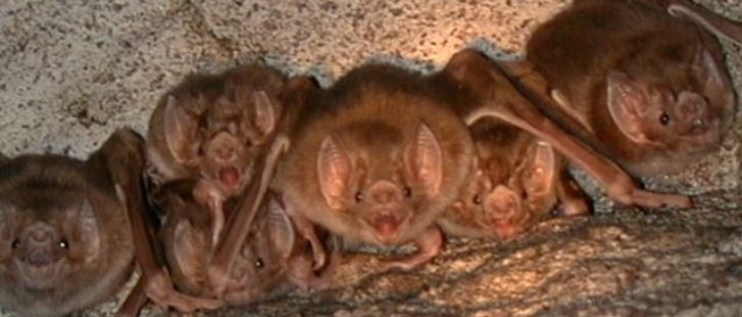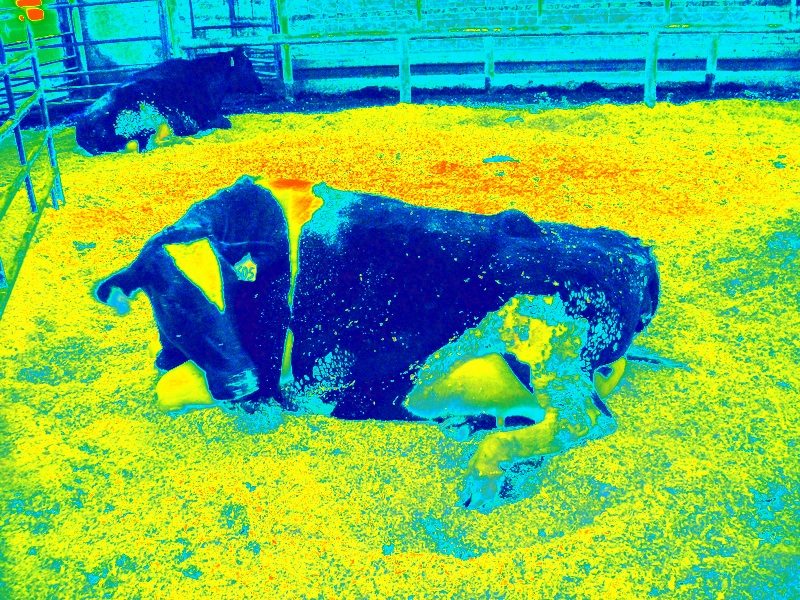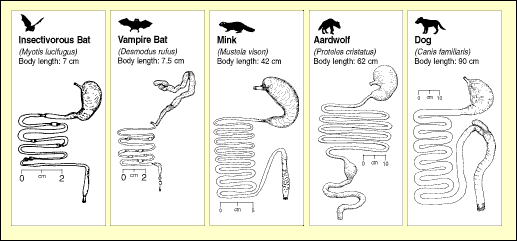
Adaptations
Desmodus rotundus have adapted in multiple ways in order to be better suited to the environments in which they live. To learn about a few adaptations that make Desmodus rotundus unique, read on!
Infrared Radiation
One of the most commonly asked questions about a vampire
bat is how they can tell where to attack their prey. The answer to
that question is quite impeccable. Vampire bats have the ability to detect
infrared radiation. This means the bat is capable of sensing exactly
where the blood of its prey is the warmest which in turn lead is them to the best place for an
incision. An experiment done by Gracheva et al. provides evidence
that the
vampire bat uses excitatory ion channels in its three sensory
ganglia located by the nose to sense infrared. As of right now,
vampire bats are the only mammals that infrared radiation detection
has been found in. This is a great adaptation for
Desmodus rotundus because
it allows the bat to better locate areas for incision in its prey (Gracheva
et al. 2011).The photo below is of
a cow but taken with a thermal radiation filter. This is an example
of how a bat views cattle before he choosing the perfect feeding
site. To learn more about the diet of the common vampire bat check
out the nutrition page.

Photo Credit to Lauren Krause and Alyssa Ward
Quick Digestion
Another great adaptation the vampire bat has is its capability for
quick digestion. In a single feeding this extremely light weight
bat, can consume up to half of its body weight. After a feeding, the
bat is no longer as lightweight making flight much more difficult.
Quick digestion of the blood consumed gets the bat the energy it
needs for survival and allows it to leave the scene of the crime in no time.
The stomach of a vampire bat
is intricate and practically twice the length of its body. As you
can infer from the above photo, the vampire bat has a stomach that
is much thinner and longer than any of the compared mammals. The
lining of the bat’s stomach is where absorption begins. The
stomach immediately begins absorbing the plasma from the blood the
bat consumes and as many of you may know, about 90 percent of plasma
is water. The bat must almost immediately begin excreting this water
therefore the kidneys must be on top of their game (cnsweb.org). The kidneys and
bladder begin excreting water before the bat is even half way done
feeding (conservationcentre.org). Because of the vampire bat's exceptionally muscular stomach
and prompt excretion by the kidneys this all blood diet is
altogether made possible (Breidenstein 1982). To learn more about
the feeding of the common vampire bats click
here.
and allows it to leave the scene of the crime in no time.
The stomach of a vampire bat
is intricate and practically twice the length of its body. As you
can infer from the above photo, the vampire bat has a stomach that
is much thinner and longer than any of the compared mammals. The
lining of the bat’s stomach is where absorption begins. The
stomach immediately begins absorbing the plasma from the blood the
bat consumes and as many of you may know, about 90 percent of plasma
is water. The bat must almost immediately begin excreting this water
therefore the kidneys must be on top of their game (cnsweb.org). The kidneys and
bladder begin excreting water before the bat is even half way done
feeding (conservationcentre.org). Because of the vampire bat's exceptionally muscular stomach
and prompt excretion by the kidneys this all blood diet is
altogether made possible (Breidenstein 1982). To learn more about
the feeding of the common vampire bats click
here.
Flight
Bats are the only mammals that can fly. This ability is a pronounced
adaptation. Bats are known to possess the same structures as other
mammals but have evolved differently. The bone structures of bat
wings are similar to those of the hands of humans, fins of
whales, and other fore limb structures. Evolutionary studies have proven that by changing the sizes
of fore limbs in different mammals (such as those previously listed)
you can create the forelimbs of a different mammal.
 Bat wings
contain the same bones as human forelimbs, so why can’t humans fly?
Although humans and bats posses similar bone structures they are
present in different proportions and shapes (earthlife.net). The bones of bats and
long and very thin which are important aspects that make the wings
great for flight. The size and curvature of the bones in a bat wing
make the wing lightweight and aerodynamic for flight. The curvature
of the vampire bat's wings make shape that tends to be more bowl-shaped. The way air passes over the
wing shape creates changes in pressure which then in turn lift the
wing causing the bat to take flight (earthlife.net). Flight gives a
vampire bat many abilities. The vampire bat has the ability to feed
and reproduce in a greater span of land but also flight makes
escaping from prey more unique.
Bat wings
contain the same bones as human forelimbs, so why can’t humans fly?
Although humans and bats posses similar bone structures they are
present in different proportions and shapes (earthlife.net). The bones of bats and
long and very thin which are important aspects that make the wings
great for flight. The size and curvature of the bones in a bat wing
make the wing lightweight and aerodynamic for flight. The curvature
of the vampire bat's wings make shape that tends to be more bowl-shaped. The way air passes over the
wing shape creates changes in pressure which then in turn lift the
wing causing the bat to take flight (earthlife.net). Flight gives a
vampire bat many abilities. The vampire bat has the ability to feed
and reproduce in a greater span of land but also flight makes
escaping from prey more unique.
Movement
on Land
Vampire bats are a species of bat that
thrive in captivity consequently making them very easy to study. One
group of researchers wanted to study this particular group of bats
because of its ability to walk
and run on terrestrial land while other species of bats are
incapable. Vampire bats are one of the few species of bats that
retain the ability to use their four limbs for quick and stealth
locomotion. The vampire bat is capable of walking forward, backward,
and side-to-side (Riskin & Hermanson 2005). When put onto a treadmill, vampire bats will
actually prove that they are indeed qualified to run at speeds up to 2
meters per second. Riskin and Hermanson compared the movement of a
walking vampire bat
to that of a mouse. When the vampire bats were put on treadmills and
began to run Riskin and Hermanson concluded that the running form of
the vampire bats were different than that of a mice. With the use of
its thumb the running of the vampire bat is much more efficient than
a scurrying mouse. The
long forearms of a vampire bat are very competent in carrying the
bat a great distance in very few strides (Riskin & Hermanson 2005).
Anticoagulant In Saliva
Vampire bat saliva is different than the
saliva of any other bat or mammal for that matter. This species of bat possesses a special
component in its saliva to make feeding more efficient. This
component is an anticoagulant known as draculin
(medicalcenter.osu.edu). This anticoagulant travels down the bats
long tongue as the blood of the bat's prey travels up. This
anticoagulant prevents the incision from clotting. Because the
incision cannot clot, the blood continuously flows to allow the bat
to feed quickly and effortlessly (Currie 2012). This anticoagulant has recently
become of great interest in the human population. To learn more about why humans are
interested in bat saliva check out
interactions.